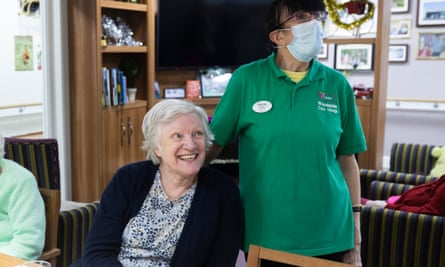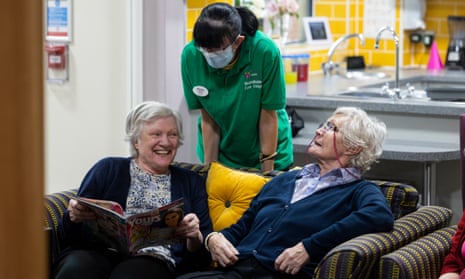It is the dementia care complex with the air of The Truman Show. Residents shop in a mini mart, hang out at the Cup Above cafe, get spruced up at Cutters Hair and Beauty. There is even a crazy golf course.
Woodside Care Village in Warwick is staged like a town centre in miniature, with benches and a fountain, cafe tables and front doors to homes styled as either “town”, “country” or “classical”. But none of the places are quite what they seem, because here everything has a greater purpose: to improve the wellbeing of people with dementia.
Modelled on a groundbreaking Dutch experiment in looking after people with Alzheimer’s disease, the purpose-built facility, which opened in 2019, is quietly breaking new ground for a better kind of dementia care.
As care inspectors uncover terrible conditions in a minority of dementia homes where standards have slumped since the start of the pandemic, the Guardian visited a place that offers hope for the UK’s fast-growing population living with dementia, which is set to grow from nearly 1 million today to 1.6 million by the middle of the century.
“Everything is dressed and staged to look familiar,” said Jo Cheshire, the communications manager for the home’s operator, WCS. “We try to make sure people aren’t severing their links with the past. We have one lady who works in the launderette with a badge, because that’s what she did before. It feels like they are contributing to the community.”
The shop stocks food and snacks but its bigger purpose is to give residents the autonomy many care homes deny. So each morning people like Pam, 69, can choose what to have for lunch before taking it back to their home, which they share with four or five other residents. It is named Ethelfleda, after a ninth-century Mercian queen. There the food is cooked up for them by a care worker, or they can cook it themselves. They can choose from fresh and dried ingredients. If they want to clean, there are products for that too. Everything is geared to creating a sense of normality and life going on, whatever the dementia diagnosis.
“People think that moving into a home, everything stops, but this is about what they want to do,” said Lorraine Herbert, the deputy care manager. “It’s the same world as the world they have been living in.”

When I arrive, Pam is finishing lunch at home with her housemates Sandra, Jean and Maureen. The first thing you notice when you enter their home is the appetising smell from the meals just cooked up by their carer, Wendy. It is nothing like the stale school dinners aroma of mass catering in many other care facilities. The home feels a little like a sitcom stage set – comfy sofa, lots of pictures, big open kitchen and private rooms for each resident.
Sat together around the table, they are talking about where they are from – “Brum”, Wolverhampton, Scotland.
“I can do the Highland fling,” says Sandra from Aberdeen.
“Can you?” asks Pam, smiling.
“Not now, dear!” replies Sandra with a wink.
They all exhibit the passing weather of dementia: confusion, then focus. One man sleeps in a chair. But there’s a sense of life going on. Plans are made for after lunch. There’s knitting club in the cafe.
“We might go for a walk,” said Pam. “There is a seat and you can watch the cars.” The paths are designed in long circuits so no-one can wander too far. All but the perimeter doors are open.
“The idea is you have freedom,” said Cheshire. “If you come upon a locked door it can increase agitation, that’s unsettling for the other residents and it makes the carer’s job harder.”
In many care homes, residents with dementia are housed on a separate floor to other people without the disease. One relative describing such a floor said it “was like going on to another planet”. Woodside is trying to keep people with dementia on the same planet and they live alongside people without the illness.

The home is run by a not-for-profit organisation, one of many that provide care homes, although 84% of care places in the UK are in for-profit communities. Fees are about £1,400 a week, which is above local authority budgets but below the £2,400 of the so-called luxury care market. Crucially, staff ratios are higher than normal, at two staff for every five or six people rather than the usual one. This means staff can spend more time interacting with the residents.
Staff are briefed with a “this is me” document, which details the likes and dislikes of each person with dementia and has photos through their lives, the time they like to get up, when they like to eat. On the wall beside each private room is a frame filled with photos and mementoes of the resident’s life so far.
“It’s so I know them before they had the illness,” said Wendy, who also keeps photos on the walls of people who used to live in Ethelfleda – “I say they are still part of us.” It is the reality of life in a care home.
The home is also innovating in other ways. Each room has acoustic and camera monitoring, if the residents consent. The purpose is to detect quickly if someone is getting up in the night or agitated, so a carer can go to them and avoid the whole house being woken. A better night’s sleep means less dozing off during the day, better eating, more exercise and less agitation. The monitoring also means 55% fewer falls too, both at night and in the daytime, said Cheshire.
There are calculated inducements for children, which encourages family visits: ping pong, a Nintendo Wii and bikes, as well as sweets in the mini mart.
A clinical trial of such “person-centred” dementia care in 69 care homes in London and Buckinghamshire published in 2020 showed that it improved quality of life for people with dementia and reduced agitation and the burden of depression or aggression. It also reduced hospital and GP visits.
Herbert reckons residents’ quality of life stays higher for longer at Woodside. Cheshire said they had also seen a reduction in the use of antidepressants. She visited Hogeweyk, the Dutch dementia village on which Woodside is based, and wondered: “This is so damn obvious, why is it not [all] like this?”
The care home still has its issues. In common with the industry, staff pay is low relative to the wider economy. If residents don’t gel with their housemates they sometimes have to be moved to another accommodation. And of course, there is death. When I visited there were a few rooms available after what Cheshire described as “a flurry of the inevitable”.
But the place crackles with opportunities for stimulation. Care Quality Commission inspectors rated it “good” last month, saying “staff were friendly and celebrated people’s individual personalities. People were supported to have maximum choice and control of their lives.”
In her room filled with pictures and mementoes, Pam leafed through her wedding album from 1974 and read out the wedding telegrams.
“It’s so important they have a sense of purpose and a sense of belonging,” said Herbert. “It’s about what they want to do each day, the friendships they build up. If one of them is not well, they recognise that. There’s a closeness.”
Before I left, Pam got up from her place in the cafe knitting circle to show me a robotic long-haired cat she likes to stroke. She tickled its tummy to keep it purring. I joined her stroking it and she took my other hand and squeezed it. She was smiling.









